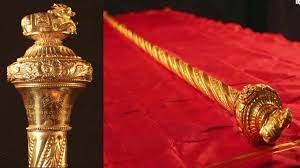‘Sengol’ is a historical sceptre from Tamil Nadu, given by the British to the first Prime Minister Jawaharlal Nehru representing the transfer of power and was kept in a museum in Allahabad. However, it will be installed in the new Parliament building to be inaugurated by Prime Minister Narendra Modi on May 28.
But when and how Sengol became a symbol of the transfer of power is an interesting tale to tell. A video of its making and transferring is also shared widely on social media.
On June 3, 1947, the last viceroy of India, Lord Mountbatten shared the partition plan as per which India was reborn as a sovereign and independent country on August 15, 1947.
To mark the succession of power, Mountbatten asked Nehru about his plans. Nehru soon turned to C. Rajagopalachari (Rajaji) for help. Rajaji was the epitome of knowledge and after days of research, he shared the ancient Tamil tradition of transfer of power. In the Chola period, the kings transferred powers to their successors by transferring ‘Sengol’.
Back then Rajaguru (court high priest) handed over the Sengol symbolizing power and justice, from the old king to the new king. The new king used to hold the Sengol and in the name of Bhagwan Shiva, they would take oath to serve and offer justice to their people.
Rajaji informed Nehru of this tradition and suggested that a Sengol (sceptre) be crafted so that the British could present the new Prime Minister with it through a Hindu priest. Nehru concurred and gave Rajaji the assignment to carry it out.
Rajaji who was a follower of Thiruvavduthurai Adheenam, one of the oldest Hindu Math founded in the 16 century. The place is located 82 kms away from Thanjavur, the then capital of the Cholas.
Rajaji immediately reached out to the 20th pontiff of the Mutt, Gurumahasannidanam Srilasri Ambalavana Desikar Swamigal. Swamigal accepted the responsibility and the making of the Sengol was entrusted to Chennai-based Vummidi Bangaru Jewellers.
The Sengol was 5 feet high, it had Nandi placed on the top as a symbol of justice and peace. There were other intricate details and rich symbols around the stem of the Sengol.
Vummidi Ethirajulu (96) and Vummidi Sudhakar (88), who are part of the Vummidi family, who were involved in the making of the Sengol are still alive today and recollect that the crafting was constantly monitored by the Adheenam.
On August 14, 1947, the mutt Kumaraswamy Thambiran Swamigal, the mutt’s odhuvar (singer) Manikka Odhuvar and Nadaswaram player TN Rajarathinam Pillai who was also the Adheenam’s Nadaswaram player were specially flown to Delhi carrying the golden Sengol with them.
As soon as the clock ticked midnight, India awake to freedom. On the other hand, the Sengol was sanctified with holy water and verses from Kolaru Padhigam of the Thirumurais (compilation of verses hailing the Hindu God Siva) were chanted. The meaning of the verses was, ‘It is our order that the follower of the lord, the King should rule, as in the heavens. The Swamigal gave the sceptre to Pandit Nehru, completing the transfer of power.
As Tamil Labs puts it, at the stroke of midnight, when the whole world slept, India awoke to life and freedom, with the sounds of the holy Thevaaram.
Well, the cultural transfer of power and the historical day was slowly forgotten under the rule of the Congress. The Sengol was later kept at the nondescript Anand Bhavan Museum in Prayagraj (then Allahabad).
On May 24, addressing a press conference, the Union Home Minister Amit Shah told media, ‘Sengol’ symbolises the transfer of power from British to India, just as it was originally used to mark the handing over power from one king to another during the Chola dynasty in Tamil Nadu.
“The ruler would be vested with the ‘Sengol’ with the order (‘aanai’ in Tamil) to rule with ‘dharma’, meaning justly and fairly,”
‘Sengol’ is a word derived from the Tamil word ‘Semmai’, meaning ‘righteousness.’ The historical sceptre was made of silver, coated with gold coated, and crowned with the sacred Nandi, with its unyielding gaze. The Nandi on top of the ‘Sengol’ is symbol of ‘nyaya.’ “Sengol represents the same feeling that Jawaharlal Nehru felt on August 14, 1947,” Shah said.
The Sengol will be installed near the chair of the Speaker in the new Parliament building.
When the Prime Minister came to know about this little-known episode of history, he ordered detailed research on it and at length decided it would be proper to install the Sengol at the temple of democracy, the country’s Parliament, Shah said.



















Comments